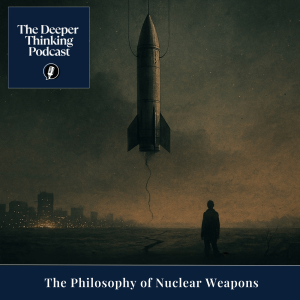
Friday Mar 21, 2025
The Philosophy of Nuclear Weapons - The Deeper Thinking Podcast
Nothing is more stable than the threat of collapse.
A glass dome can hover for decades before it shatters. The sky remains blue even as it hangs by filaments of protocol, blink reflexes, and split-second judgments. To live under nuclear deterrence is to believe in the logic of balance while standing on the edge of obliteration. The missiles do not fire, and so we say the system works. The missiles do not fire, and so we forget what they mean. Somewhere, a steel door closes over a warhead, and the silence it leaves behind is mistaken for safety.
The doctrine of deterrence rests on an idea that appears rational: that the fear of total destruction prevents action. But rationality is not uniform. It flickers in the hands of fallible people, misread signals, overheard threats, and flawed algorithms. It is easy to imagine deterrence as a chessboard, each move calculated, every outcome reversible. But chess does not allow the board to melt, the pieces to dream, the timer to malfunction. A single misstep is not corrected but unleashed. One man forgets a launch code. One satellite mistakes sunlight for a missile. A drill is not announced. The system does not fail—until it does, forever.
In the ruins of World War II, nuclear weapons were framed as harbingers of peace. They ended the war, some said. They prevented the next one, others claimed. Yet deterrence is not peace—it is a standoff, a choreography of threat. Hannah Arendt spoke of the banality of evil, but nuclear weapons suggest a banality of apocalypse: so woven into geopolitical logic that their presence no longer shocks. The horror of them becomes theoretical. The names of the bombs—Little Boy, Fat Man—carry a surreal domesticity. But the bodies in Hiroshima did not vanish in theory. They were shadows burned into stone.
There is no clean word in English for the kind of grief that anticipates itself. The German term *Verschlimmbesserung* suggests an attempt to fix something that only makes it worse. Deterrence as a solution breeds this paradox. It solves a war by threatening the end of all wars. It prevents use by promising use. It keeps peace not through trust but through terror. Each generation learns to live with the bomb, then forgets to be afraid of it, then builds smarter, smaller, faster versions. Mutually assured destruction becomes a cliché. The mushroom cloud becomes a pop artifact. The glass dome returns, invisible now.
Somewhere, a child draws a picture of the Earth cracked in half, and the teacher nods. Somewhere, a military AI flags a launch pattern as anomalous, but the operator has stepped away. Somewhere, a diplomat stares too long at the blinking cursor of an unsent warning. The imagination reels, not with what has happened, but what hasn't—yet. Russell once wrote that only fools trust in perpetual luck. The logic of deterrence requires not just luck, but unbroken luck. It asks to be believed in but never tested. It is a faith in non-event.
And still, the image recurs. The steel door sliding shut. The cold quiet hum beneath the desert. But it changes. At first, the silence felt like restraint. Then it felt like numbness. Now it feels like waiting. A strange waiting. A waiting that sounds like forgetting. A waiting that feels like sleepwalking across a floor made of glass, over a void whose name has been erased from the map. How long can a silence last before it becomes a lie?
No comments yet. Be the first to say something!